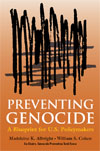
Last winter, the bi-partisan Genocide Prevention Task Force, co-chaired by Clinton era cabinet officials Madeleine Albright and William Cohen released its “Blueprint for U.S. Policymakers.” Their findings, based on exhaustive interviewing, were more than a year in the making. The Task Force gets it right in demonstrating that genocide prevention is a national security issue and recommending that the United States prioritize the prevention of mass atrocities.
The United States Holocaust Memorial Museum played an integral role in the Task Force and recently amalgamated U.S. government actions in regards to the recommendations since the report’s release six months ago. President Obama and high level members of his administration, including Vice President Biden and U.N. Ambassador Rice, have addressed the necessity of genocide prevention. Congressman Howard Berman included language in the House Foreign Relations Authorization Act that requires a report “outlining specific plans for the development of a government-wide strategy and the strengthening of United States civilian capacities for preventing genocide and mass atrocities.” Furthermore, the intelligence community has committed to improving its mechanisms for identifying countries at risk of mass atrocities, and the administration’s budget includes recommended increases in diplomatic and contingency funding that could be use for prevention efforts.
These gains are laudable and their implementation is demonstrative of the clarity of the recommendations and the intellectual heft of the Task Force members. However, there are concerns that even more has not been accomplished. Concrete, commonsensical actions at the highest levels are necessary for the United States to better respond to the threat of mass atrocities. Rhetoric and promises must be followed by action.
Experts at organizations around the country and within the government continue to dialogue and work together to implement the blueprint laid out by Albright and Cohen. The hard work of ensuring that the United States does its part to make “Never Again” a reality can and should remain a priority.

